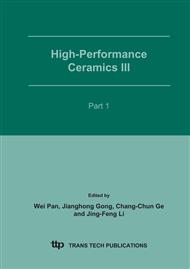p.1765
p.1771
p.1775
p.1779
p.1783
p.1787
p.1791
p.1795
p.1801
Design and Fabrication of an Advanced Ceramic Material Based on the Wear Resistance
Abstract:
An optimum model for the composition design of the advanced ceramic material is built based on the wear resistance with the combination of both theoretical and experimental methods, with KIC 3/4×H1/2 working as the coefficient of wear resistance when the abrasive wear dominates. Results show that the tested SiC/(W,Ti)C/Al2O3 ceramic material can be expected to achieve the highest wear resistance when the volume fraction of SiC and (W,Ti)C is about 15% and 17%, respectively. The optimum composite is then fabricated with the hot pressing technique. Its wear resistance is approximately 43% higher than that of the pure alumina ceramic when used as the tool material in the machining of the hardened tool steel. The increment of the wear resistance of the developed ceramic material coincides well with that predicted from the optimum model. It proves that the method proposed in the present study is feasible for the ceramic materials mainly with wear mechanisms of abrasive wear.
Info:
Periodical:
Pages:
1783-1786
Citation:
Online since:
February 2007
Authors:
Keywords:
Price:
Сopyright:
© 2005 Trans Tech Publications Ltd. All Rights Reserved
Share:
Citation:


